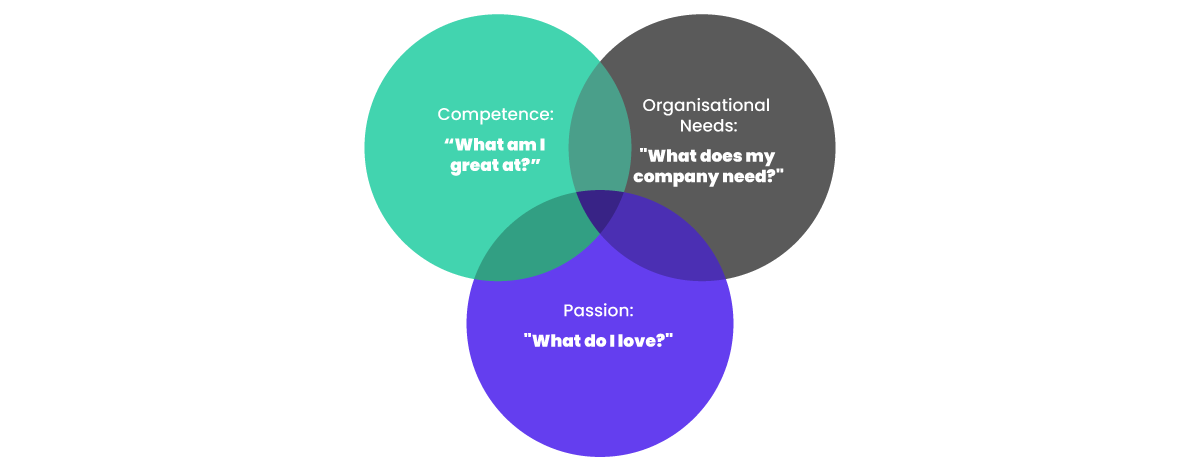How to: Create a CPD action plan
19 Aug 2021Resource
Continuing Personal Development (CPD) may be a regulatory requirement when it comes to maintaining your Allied Health Professional status, but it can (and should!) be so much more than just a tick box exercise. The key is to ensure you have a CPD action plan in place.
Your CPD time may be limited, but by asking yourself some key questions you can develop a plan that will allow you to spend it wisely - for the good of yourself and your service users.
Before we look at those questions, it’s helpful to highlight that your CPD ‘sweet spot’ lies within the intersection of at least three areas (and perhaps there are other areas personal to you here):
- The needs of your department and service users
- Your personal passion
- Your current areas of expertise and competence
I feel a Venn-diagram coming on…

By considering your strengths and where your energy and motivation truly lie, this will give you a foundation to build on. HOWEVER, it’s important to also think about the applications of any CPD you are considering back in the workplace. As the relevancy diminishes, so does your ability to be able to make use of the learning, leaving you merely with a certificate to file away. It may also be harder to gain approval (and possibly funding) for the training in this situation.
So, back to those key questions:
1. What are my critical skills, knowledge, and abilities?
This is not the time for modesty. If you can’t be honest with yourself about where your strengths currently lie then you won’t be able to create a worthwhile future path. This is where peer feedback can be very valuable, so if you’re struggling, ask your colleagues for help.
2. What parts of my role do I most enjoy, and why?
The ‘why’ is the key component here, as it leads you to a better understanding of what makes you tick. It may also provide vital clues as to where you want to take your career in the future.
3. What are my short and long-term career goals?
Once you know where your drive is, think about how you can harness that to progress your career. What direction would you like to take your career - is it a vertical move up the ladder within your current department, or do you want to move horizontally into a different area or specialism?
Do not lose sight of your responses to questions one and two at this point.
It is very easy for self-doubt to creep in or barriers to appear in your mind, however, this is the time to keep all options on the table. If you don’t allow your mind to go there, you will never consider the path to get there (profound, right?).
Don’t forget the good old SMART acronym here - specific time-bound objectives that you know you can realistically achieve will again make your CPD time far more efficient and rewarding! Breaking the longer-term goals down into shorter milestones will really help.
4. What are my development needs?
I’m purposely leaving out the word ‘weaknesses’ here - let’s keep this positive! This is where you can actually begin to plan your CPD, yay!
Think about the gaps in your current capabilities that are preventing you from reaching your goals above. When it comes to the long-term goals, there may be lots, and that’s OK! You can’t tackle everything at once, which is why the short-term goals are there to help break it down.
Consider that the gaps may not just be in relation to clinical capabilities, but also the softer skills. For example, critical thinking, confidence in presenting, or time planning. So think about ALL the areas that you feel you need to work on. Again, you might find it helpful to discuss this with someone, be that your manager, a mentor, or a friend. You don’t have to work all this out on your own.
5. How will I achieve my goals?
Here is the action! You know where you are now, where you want to go and what you need to get there. Now you have to work out how you are going to do it. What opportunities are there to develop yourself in the areas you have highlighted above?
Think about that huge spectrum of CPD activities (see our online magazine for profession-specific resources), not just the standard training courses. And think about what you can realistically achieve in the coming months and year/s. Make sure that each development activity you carry out is linked in some way to your reflection above.
6. What have I learned?
Did someone say reflection?? Well, this is an important final piece of the puzzle that will keep your action plan fresh, relevant, and not just something you look at once a year. Try to diarise some time each month to reflect on any CPD you have done, formal or otherwise. If you want some support on how to effectively reflect, check out this article.
With your plan in place and CPD well within your consciousness, you may just find that a lot more exciting opportunities will present themselves to you along the way. So make sure you keep things flexible, stay open to opportunities, and first and foremost make sure you are enjoying what you’re doing! If it feels like box ticking, it’s probably time to change things up.
Good news - if you are a Julia user, you can easily keep a record of your CPD and reflect on it from your phone or desktop! If you’re not, visit How It Works to see what you’re missing out on.
Julia helps you record, reflect, and report on your CPD through our website and app.
It's an easy way for you to stay on top of your CPD. Sign up for a 14 day free today.